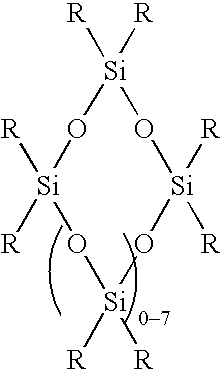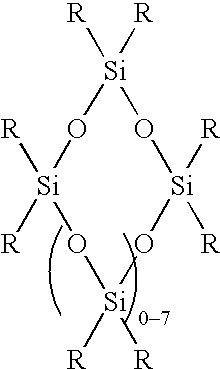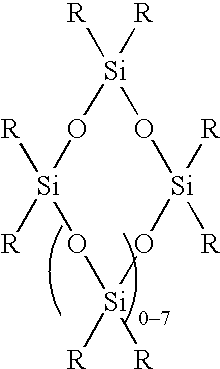Transparent Flame Retardant Polycarbonate Compositions
a technology of transparent flame retardant polycarbonate and composition, which is applied in the direction of special tyres, transportation and packaging, tyre parts, etc., can solve the problems of inherently flammable polycarbonate resin, prohibitively increasing the price, and nearby materials catching fir
- Summary
- Abstract
- Description
- Claims
- Application Information
AI Technical Summary
Benefits of technology
Problems solved by technology
Method used
Image
Examples
example 1
A polycarbonate resin was melt polymerized in the presence of 80 ppb sodium hydroxide at a reaction temperature of about 290#C. The resulting product had a weight average molecular weight of 29,500 g / mol, as determined by GPC, and contained 2000 ppm of Fries branched impurities (See U.S. Pat. No. 6,184,335). Pellets of the product were extrusion compounded with 0.0925% potassium perfluorobutane sulfonate, 0.08% cyclic octaphenyl siloxane, 0.05% of a heat stabilizer (Irgafos 168), 0.4% PETS mold release, and various levels of butyl tosylate, as an acidic quencher. The compositions were then molded into standard bars at a thickness of 1.6 mm and tested for fire resistance. The results are summarized in Table 1. The 5-Bar Flame Out Times (FOT) were calculated based on 20-Bar Burns.
As shown, the best results were achieved at butyl tosylate addition levels of 1 to 10 ppm. This corresponded to a molar ratio of about 2 to 25, preferably 2.4 to 24. A haze of less than 1% was observed for...
example 2
The experiment of Example 1 was repeated, except that phosphorous acid (45 weight % in water) was used as the acidic quencher. The results are summarized in Table 2.
In this case, the best results are achieved with 1 or 2 ppm phosphorous acid, which corresponds to a molar ratio of 1 to 15, which is equivalent to 1 to 30 assuming the phosphorous acid is acting as a monoprotic acid.
example 3
A polycarbonate resin was melt polymerized in the presence of 105 ppb sodium hydroxide at a reaction temperature of about 290#C. The resulting product had a weight average molecular weight of 27,500 g / mol, as determined by GPC, and contained 1750 ppm of Fries branched impurities. 0.090% potassium perfluorobutane sulfonate, 0.08% cyclic octaphenyl siloxane, 0.05% of a heat stabilizer (Irgafos 168), 0.4% PETS mold release, and 3.5 ppm butyl tosylate were added directly via a losing weight feeder and a side feeder. The pellets were then molded into standard flame bars at a thickness of 1.6 mm and tested. The 5 Bar FOT was 30.6, the Flame Drip was 0 / 20 and the UL rating was V0. In this example, the mole ratio is 2.6. Excellent flame retardance characteristics were observed, even at the lower level of flame retardant.
PUM
| Property | Measurement | Unit |
|---|---|---|
| Fraction | aaaaa | aaaaa |
| Fraction | aaaaa | aaaaa |
| Thickness | aaaaa | aaaaa |
Abstract
Description
Claims
Application Information
 Login to View More
Login to View More - R&D
- Intellectual Property
- Life Sciences
- Materials
- Tech Scout
- Unparalleled Data Quality
- Higher Quality Content
- 60% Fewer Hallucinations
Browse by: Latest US Patents, China's latest patents, Technical Efficacy Thesaurus, Application Domain, Technology Topic, Popular Technical Reports.
© 2025 PatSnap. All rights reserved.Legal|Privacy policy|Modern Slavery Act Transparency Statement|Sitemap|About US| Contact US: help@patsnap.com



